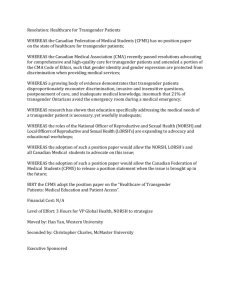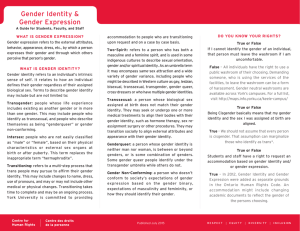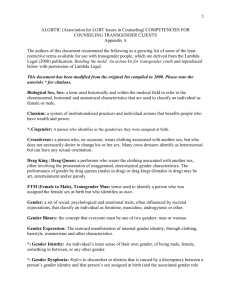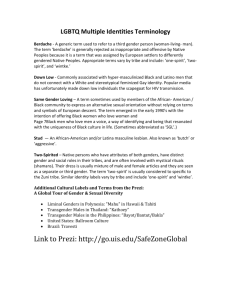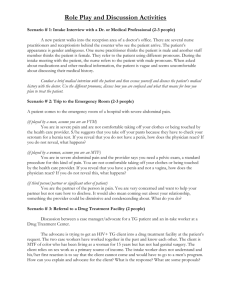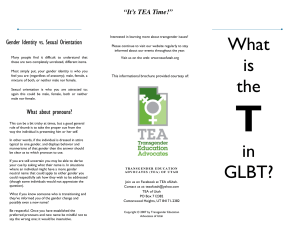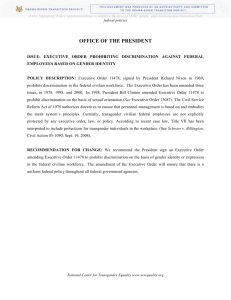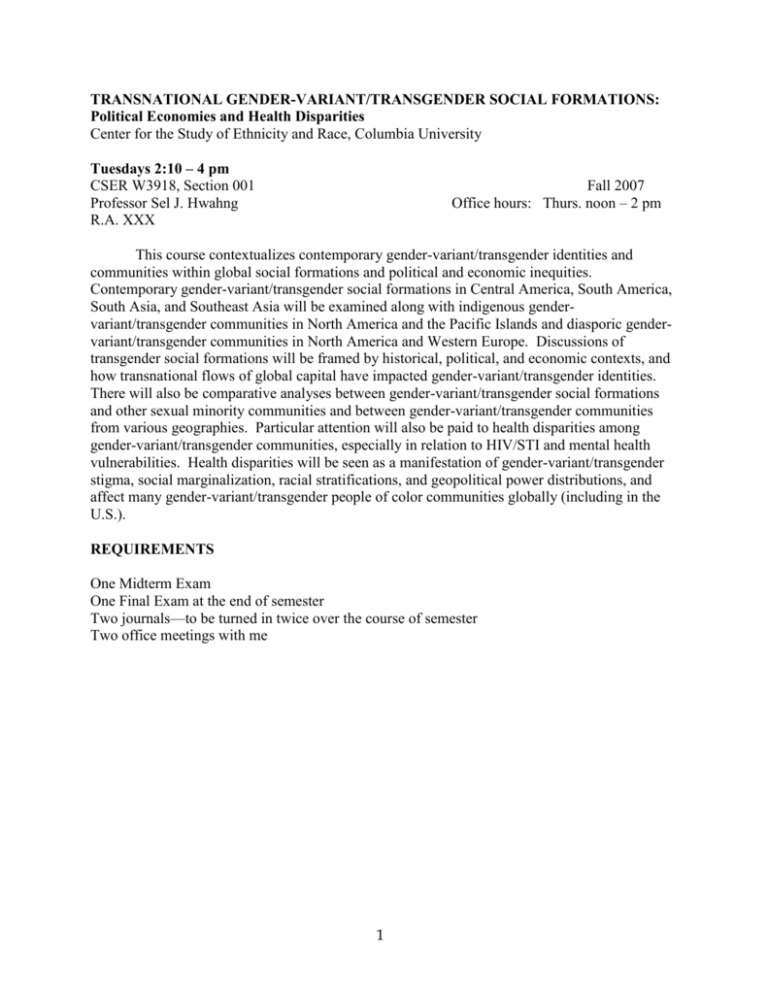
TRANSNATIONAL GENDER-VARIANT/TRANSGENDER SOCIAL FORMATIONS:
Political Economies and Health Disparities
Center for the Study of Ethnicity and Race, Columbia University
Tuesdays 2:10 – 4 pm
CSER W3918, Section 001
Professor Sel J. Hwahng
R.A. XXX
Fall 2007
Office hours: Thurs. noon – 2 pm
This course contextualizes contemporary gender-variant/transgender identities and
communities within global social formations and political and economic inequities.
Contemporary gender-variant/transgender social formations in Central America, South America,
South Asia, and Southeast Asia will be examined along with indigenous gendervariant/transgender communities in North America and the Pacific Islands and diasporic gendervariant/transgender communities in North America and Western Europe. Discussions of
transgender social formations will be framed by historical, political, and economic contexts, and
how transnational flows of global capital have impacted gender-variant/transgender identities.
There will also be comparative analyses between gender-variant/transgender social formations
and other sexual minority communities and between gender-variant/transgender communities
from various geographies. Particular attention will also be paid to health disparities among
gender-variant/transgender communities, especially in relation to HIV/STI and mental health
vulnerabilities. Health disparities will be seen as a manifestation of gender-variant/transgender
stigma, social marginalization, racial stratifications, and geopolitical power distributions, and
affect many gender-variant/transgender people of color communities globally (including in the
U.S.).
REQUIREMENTS
One Midterm Exam
One Final Exam at the end of semester
Two journals—to be turned in twice over the course of semester
Two office meetings with me
1
Books
Beauty and power: transgendering and cultural transformation in the southern Philippines—
Mark Johnson
Becoming two-spirit: gay identity and social acceptance in Indian country—Brian Joseph Gilley
Changing ones: third and fourth genders in Native North America—Will Roscoe
From toads to queens: transvestism in a Latin American setting—Jacobo Schifter
Honey, Honey, Miss Thang: being black, gay, and on the streets—Leon E. Pettiway
Killing us quietly: Native Americans and HIV/AIDS—Irene S. Vernon
Latino gay men and HIV: culture, sexuality, and risk behavior—Rafael M. Diaz
Male bodies, women’s souls: personal narratives of Thailand’s transgendered youth—LeeRay
Costa and Andrew Matzner
Mema’s house, Mexico City: on transvestites, queens, and machos—Annick Prieur
Men who sell sex: international perspectives on male prostitution and HIV/AIDS—Peter
Aggleton, ed.
Neither man nor woman: the hijras of India—Serena Nanda
Race in another America: the significance of skin color in Brazil—Edward Telles
Streets, bedrooms and patios: the ordinariness of diversity in urban Oaxaca—Michael James
Higgins and Tanya Coen
The everyday lives of sex workers in the Netherlands—Katherine Gregory
The mak nyahs: Malaysian male to female transsexuals—Te Yik Koon
The rule of racialization: class, identity, governance—Steve Martinot
Toms and dees: transgender identity and female same-sex relationships in Thailand—Megan J.
Sinnott
Transgender and HIV: risks, prevention, and care—Walter Bockting and Sheila Kirk, eds.
Travesti: sex, gender and culture among Brazilian transgendered prostitutes—Don Kulick
Two-spirit people: Native American gender identity, sexuality, and spirituality—Sue-Ellen
Jacobs, Wesley Thomas, and Sabine Lang, eds.
With respect to sex: negotiating hijra identity in South India—Gayatri Reddy
Articles
“Eo na Mahu o Hawai'i: the extraordinary health needs of Hawai'i's Mahu”—Carol Odo
“Health and health care among male-to-female transgender persons who are HIV positive”—Rita
Melendez et al.
“HIV risk behaviors among male-to-female transgender persons of color in San Francisco”—
Tooru Nemoto et al.
“HIV risk behaviours among male-to-female transgenders in comparison with homosexual or
bisexual males and heterosexual females”—Tooru Nemoto et al.
“Homophobia and the Ethnoscape of Sex Work in Rio de Janeiro”—Patrick Larvie
“It’s really a hard life”: love, gender and HIV risk among male-to-female transgender persons—
Rita Melendez et al.
“Latino men’s sexual behavior with transgender persons”—Walter Bockting et al.
“Male homosexuality and seropositivity: the construction of social identities in Brazil—Veriano
Terto Jr.
“Masculinity in Indonesia: genders, sexualities, and identities in a changing society”—Dede
Oetomo
“Migration, sexual subcultures, and HIV/AIDs in Brazil”—Richard G. Parker
2
“Mobility, marriage, and prostitution: sexual risk among Thai in the Netherlands”—Gilbert
Herdt
“Perceived risks and benefits of sex work among transgender women of color in San
Francisco”—Lydia Sausa et al.
“Polynesian gender liminality through time and space”—Niko Besnier
“Promoting health for transgender women”–Tooru Nemoto et al.
“Sex workers, fem queens, and crossdressers: racial marginalizations and HIV vulnerabilities
among MTF ethnocultural communities in New York City”—Sel J. Hwahng and Larry
Nuttbrock
“Social context of HIV risk behaviours among male-to-female transgenders of colour”—Tooru
Nemoto et al.
“The Latin Americanization of race relations in the U.S.”—Eduardo Bonilla-Silva and Karen
Glover
“The production of knowledge on sexuality in the AIDS Era: some issues, opportunities, and
challenges”—Carlos F. Caceres
DVDs and Videos
Beautiful boxer, dir. Ekachai Uekrongtham, 2003
Hijras: seeped in myth, seeking reconciliation, dir. Manoj Raghuvanshi, 2003
Juchitán queer paradise, dir. Patricio Henriquez, 2002
Mariposas en el andamio, dir. Margaret Gilpin and Luis Felipe Bernaza, 1996
Paris is burning, dir. Jennie Livingston, 1990
Sunflowers, dir. Shawn Hainsworth, 1997
The aggressives, dir. Daniel Peddle, 2005
The butterflies, dir. Vagner de Almeida, 2006
The salt mines, dir. Susana Aikin and Carlos Aparicio, 1990
Two-spirit people: the berdache tradition in Native American culture, dir. Michel Beauchemin,
Lori Levy, and Gretchen Vogel, 1992
Woubi cheri, dir. Philip Brooks and Laurent Bocahut, 1998
3



